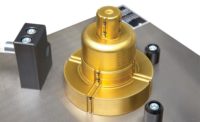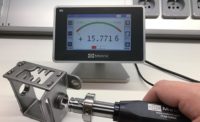In recent years, we have seen an upward trend of higher production manufacturers wanting to integrate their air gaging quality checks from a stand-alone, outside of machine device where the operator is performing a manual check, to an automated in-process gage. There are several reasons for this trend, including higher quality standards and tighter tolerancesas well as running a leaner operation. The benefits are 100% inspection of the required geometric callout, as well as handshaking between measuring device and machine to make each piece better than the prior one and remove any bad parts.
The terms in-process and air gaging may not immediately sound like they go together. Typically, in-process gaging is some form of contact gage that is done very close to the grinding wheel or cutting tool. This process is very effective, but limited in what you are able to check. In most cases, you are simply checking a diameter. Whenair gaging is used in-process, there is typically some simple handling systemto remove the part from the chuck or centers and place it into the air gage. Depending on the machine type, the air gage may be able to measure the part while still being clamped into the machine.
So, why would someone use air gaging instead of the usual contact method of in-process gaging? As I mentioned previously, the contact method is typically used for measuring a diameter and in most cases that is an outside diameter. Air gaging can be very effective at measuring more complex features such as multiple diameter steps, tapers and more sophisticated geometric callouts such as perpendicularity, straightness, parallelism and many others. It is also a very effective method for checking inside diameters including extremely small bores.
You also get the other standard benefits of air gaging, which include noncontact measuring so you don’t mark the parts and wear out the gages too quickly; a high level of repeatability;and, as mentioned before, you can measure more complex features because the air gage is designed and built for a specific task. Most contact methods are available as an option on the machine and are limited to simple features only.
A typical setup of an in-process air gage would consist of a lathe or a grinding machine turning or grinding the workpiece. Once that process is completed, the part would either be placed on or in the air gage or the air gage would be placed on or in the workpiece through some simple handling device. We are finding that many times robots are already being used to load and unload machines and can simply be reprogrammed to handle the air gaging task as well. The air gage column is then handshaking with the PLC (Programmable Logic Controller) or robot. The communication is typically handled through digital input/outputs. Common handshaking would include the PLC communication to the column that the part is now in the gage and to start the measurement.
The column would then measure the part and send a signal to the PLC indicating that part as good or bad (accept/reject). The column would also send the offset values to the machine to make the next piece equal or better than the one just measured. This would typically be done either through the RS232 outputor via Ethernet. The handling system would then remove the workpiece and place it in the appropriate location according to the good or bad signal it received. The column can also save the data to any standard SPC system. There are other options available, such as serial number tracking of each workpiece.
The return on investment (ROI) of this type of setup will happen much more quickly than you might think. The benefit of inspecting 100% of your workpieces and automatically sorting the good/bad parts ensures that you don’t accidentally send a bad piece to a customer. That coupled with the fact that you are automatically making offset adjustments, which means that each piece is equal to or better than the prior piece, would result in less scrap. Those benefits and the labor cost saved from having a person or several people throughout a three-shift operation manually checking each part would justify the investment in a very short timeframe. In addition, your spindle runtime and workpiece output will both increase using this method because while you are measuring one piece you are already making the next one. This ROI happens even faster if a robot for loading/unloading is already present in the manufacturing cell. If you have mid- to high-production parts that you are currently measuring offline using air gaging, you should give a serious look at automating the process.







